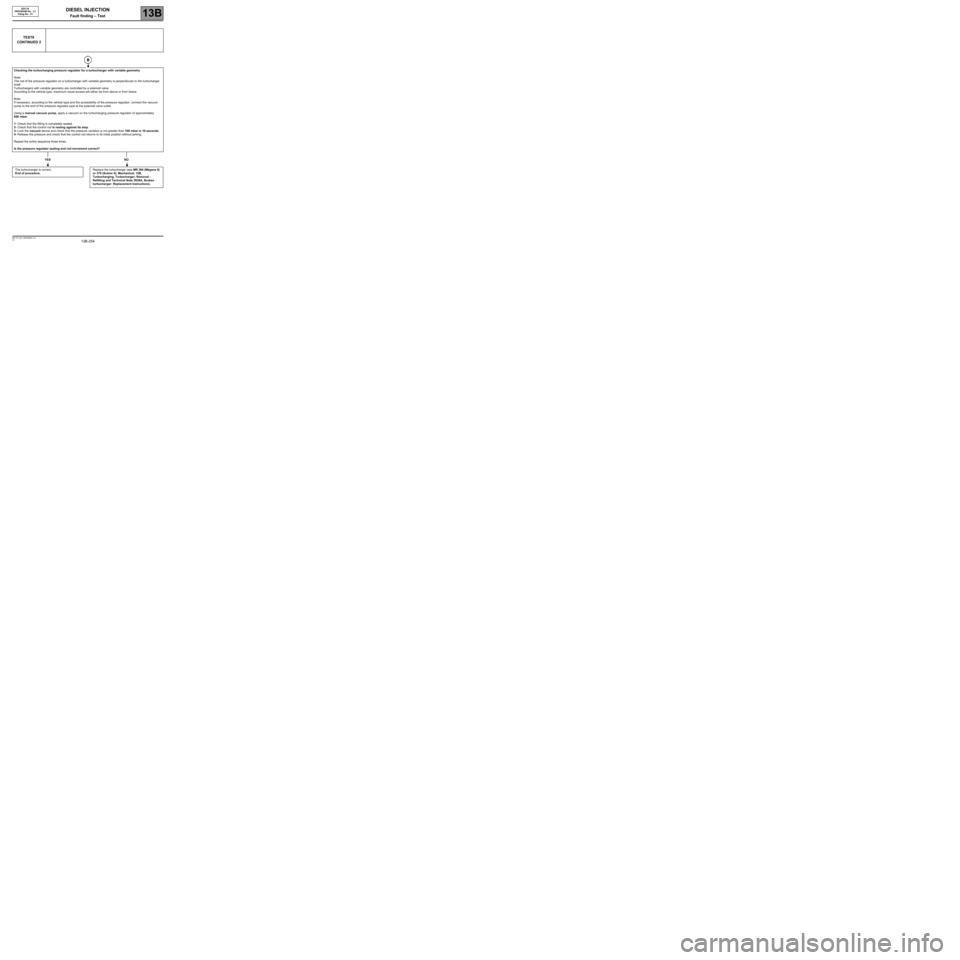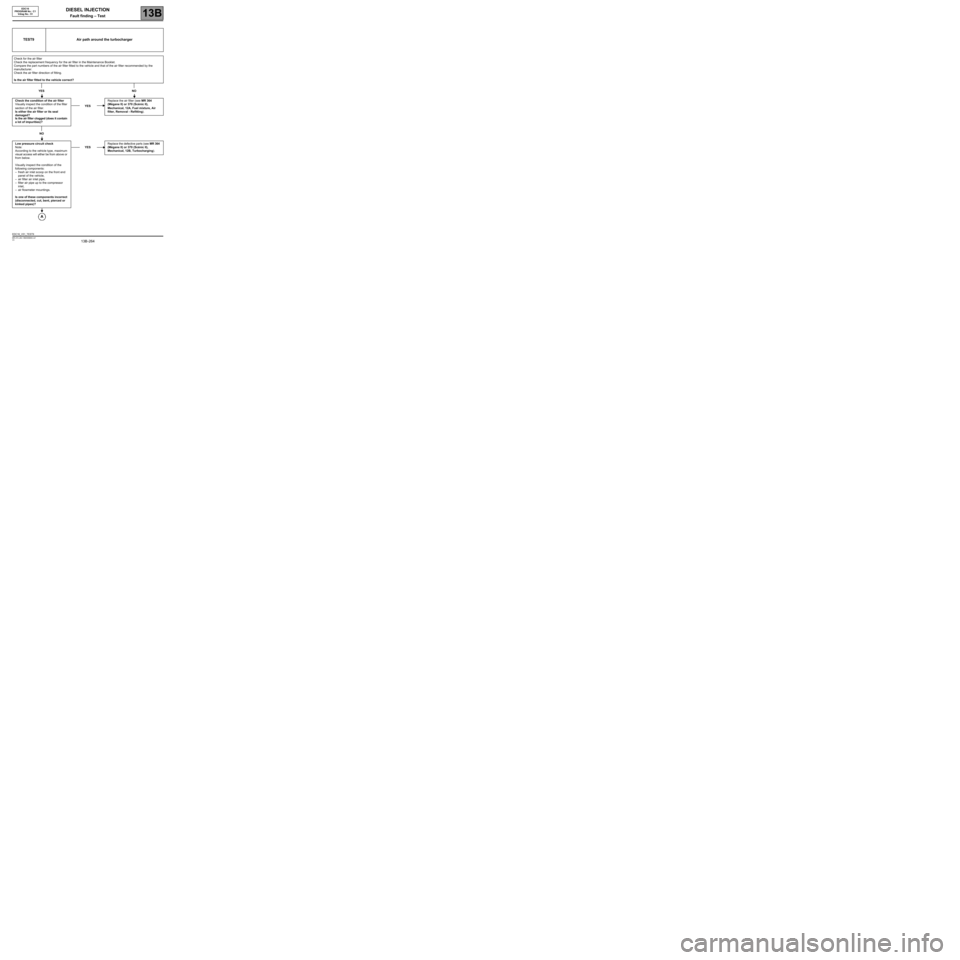Page 252 of 273

DIESEL INJECTION
Fault finding – Test13B
13B -252V3 MR-372-J84-13B250$900.mif
EDC16
PROGRAM No.: C1
Vdiag No.: 51
TEST6 Turbocharger
IMPORTANT
Perform these checks without removing the turbocharger and with the vehicle ignition switched off.
Check the turbocharger shaft
WARNING
Respect the following safety precautions:
–wear heat resistant gloves when the engine is hot,
–do not wear loose or baggy clothing and do not wear loose hanging jewellery,
–be aware that the cooling fan assembly may be triggered and pay attention to the operation of the accessories
belt or belts.
Note:
The turbocharger shaft is the shaft connecting the compressor wheel and the turbine wheel.
According to the vehicle type, maximum visual access will either be from above or from below.
Disconnect the air pipe located between the turbocharger and the air filter.
Wearing gloves, check the operation of the turbocharger shaft by turning the vanes manually without forcing.
Is there a point of resistance when the shaft is rotated?
Does the compressor wheel touch the turbocharger housing?
If for these 2 questions the response is NOIf YES for one of these 2 questions
Replace the turbocharger (see MR 364 (Mégane II) or
370 (Scénic II), Mechanical, 12B, Turbocharging,
Turbocharger: Removal - Refitting and Technical
Note 3938A, Broken turbocharger: Replacement
instructions).
EDC16_V51_TEST6
Page 253 of 273
DIESEL INJECTION
Fault finding – Test13B
13B -253V3 MR-372-J84-13B250$900.mif
EDC16
PROGRAM No.: C1
Vdiag No.: 51
TEST6
CONTINUED 1
Check the condition of the turbocharger vanes
Note:
Use a mirror and light to facilitate this check.
According to the vehicle type, maximum visual access will either be from above or from below.
Visually check that the compressor vanes are in good condition.
Are the vanes damaged or twisted?
NO YES
Replace the turbocharger (see MR 364 (Mégane II)
or 370 (Scénic II), Mechanical, 12B,
Turbocharging, Turbocharger: Removal -
Refitting and Technical Note 3938A, Broken
turbocharger: Replacement instructions).
What is the type of turbocharger?
Variable geometry
turbochargerTurbocharger with
fixed geometry
Page 254 of 273

DIESEL INJECTION
Fault finding – Test13B
13B -254V3 MR-372-J84-13B250$900.mif
EDC16
PROGRAM No.: C1
Vdiag No.: 51
TEST6
CONTINUED 2
Checking the turbocharging pressure regulator for a turbocharger with variable geometry
Note:
The rod of the pressure regulator on a turbocharger with variable geometry is perpendicular to the turbocharger
shaft.
Turbochargers with variable geometry are controlled by a solenoid valve.
According to the vehicle type, maximum visual access will either be from above or from below.
Note:
If necessary, according to the vehicle type and the accessibility of the pressure regulator, connect the vacuum
pump to the end of the pressure regulator pipe at the solenoid valve outlet.
Using a manual vacuum pump, apply a vacuum on the turbocharging pressure regulator of approximately
650 mbar.
1- Check that the fitting is completely sealed.
2- Check that the control rod is resting against its stop.
3- Lock the vacuum device and check that the pressure variation is not greater than 100 mbar in 10 seconds.
4- Release the pressure and check that the control rod returns to its initial position without jerking.
Repeat the entire sequence three times.
Is the pressure regulator sealing and rod movement correct?
YES NO
The turbocharger is correct.
End of procedure.Replace the turbocharger (see MR 364 (Mégane II)
or 370 (Scénic II), Mechanical, 12B,
Turbocharging, Turbocharger: Removal -
Refitting and Technical Note 3938A, Broken
turbocharger: Replacement instructions).
Page 255 of 273

DIESEL INJECTION
Fault finding – Test13B
13B -255V3 MR-372-J84-13B250$900.mif
EDC16
PROGRAM No.: C1
Vdiag No.: 51
TEST6
CONTINUED 3
Checking the turbocharging pressure regulator for a turbocharger with fixed geometry
Note:
The pressure regulator rod for a turbocharger with fixed geometry is line with the turbocharger shaft.
Turbochargers with fixed, regulated geometry are controlled by a solenoid valve.
According to the vehicle type, maximum visual access will either be from above or from below.
Note:
If necessary, according to the vehicle type and the accessibility of the pressure regulator, connect the vacuum
pump to the end of the pressure regulator pipe at the solenoid valve outlet.
Using a manual vacuum pump, apply a vacuum on the turbocharging pressure regulator of approximately
650 mbar.
1- Check that the fitting is correctly sealed.
2- Check that the control rod moved several millimetres.
3- Lock the vacuum device and check that the pressure variation is not greater than 100 mbar over 10 seconds.
4- Release the pressure and check that the control rod returns to its initial position without jerking.
Repeat the entire sequence three times.
Is the pressure regulator sealing and rod movement correct?
YES NO
The turbocharger is correct.
End of procedure.Replace the turbocharger (see MR 364 (Mégane II)
or 370 (Scénic II), Mechanical, 12B,
Turbocharging, Turbocharger: Removal -
Refitting and Technical Note 3938A, Broken
turbocharger: Replacement instructions).
Page 264 of 273

DIESEL INJECTION
Fault finding – Test13B
13B -264V3 MR-372-J84-13B250$900.mif
TEST9 Air path around the turbocharger
Check for the air filter
Check the replacement frequency for the air filter in the Maintenance Booklet.
Compare the part numbers of the air filter fitted to the vehicle and that of the air filter recommended by the
manufacturer.
Check the air filter direction of fitting.
Is the air filter fitted to the vehicle correct?
YES NO
Check the condition of the air filter
Visually inspect the condition of the filter
section of the air filter.
Is either the air filter or its seal
damaged?
Is the air filter clogged (does it contain
a lot of impurities)?YESReplace the air filter (see MR 364
(Mégane II) or 370 (Scénic II),
Mechanical, 12A, Fuel mixture, Air
filter, Removal - Refitting).
NO
Low pressure circuit check
Note:
According to the vehicle type, maximum
visual access will either be from above or
from below.
Visually inspect the condition of the
following components:
–fresh air inlet scoop on the front end
panel of the vehicle,
–air filter air inlet pipe,
–filter air pipe up to the compressor
inlet,
–air flowmeter mountings.
Is one of these components incorrect
(disconnected, cut, bent, pierced or
kinked pipes)?YESReplace the defective parts (see MR 364
(Mégane II) or 370 (Scénic II),
Mechanical, 12B, Turbocharging).
EDC16
PROGRAM No.: C1
Vdiag No.: 51
EDC16_V51_TEST9
Page 265 of 273

DIESEL INJECTION
Fault finding – Test13B
13B -265V3 MR-372-J84-13B250$900.mif
EDC16
PROGRAM No.: C1
Vdiag No.: 51
TEST9
CONTINUED
High pressure circuit check
Note:
According to the vehicle type, maximum visual access will either
be from above or from below.
Visually inspect the condition of the following components:
–outlet pipe of the compressor to the turbocharging air cooler,
–turbocharging air cooler outlet pipe at inlet manifold,
–inlet manifold,
–temperature and pressure sensors.
Is one of these components incorrect (disconnected, cut,
bent, pierced or kinked pipes)?YESReplace
the defective parts
(see MR 364
(Mégane II) or 370
(Scénic II),
Mechanical, 12B,
Turbocharging).
NO
Exhaust system check
Visually inspect the condition of the following engine parts:
–the exhaust manifold circuit to the turbocharger turbine,
–the turbine outlet pipe to the end of the exhaust pipe,
–the inlet manifold to the EGR valve
–check that the temperature and pressure sensors are
connected.
Do some of these components have black or white marks on
them? YES
NO
Run test 5 Turbocharger control solenoid valve check.